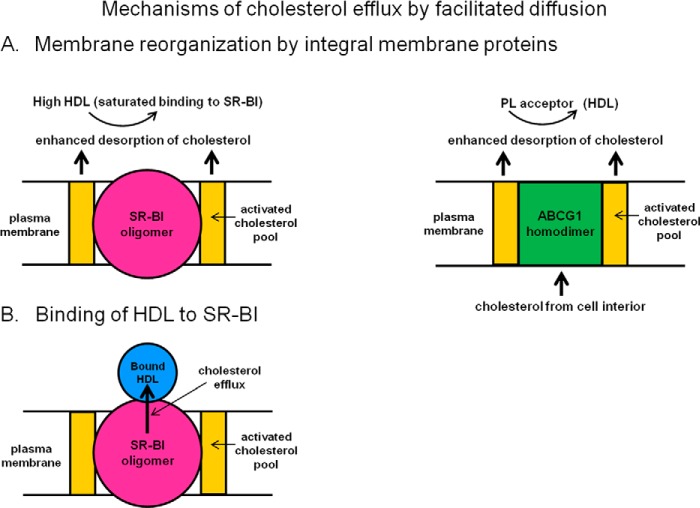FIGURE 2.
Mechanisms of cellular cholesterol efflux by facilitated diffusion. A, this schematic shows that the presence of the integral membrane proteins, SR-BI and ABCG1, leads to formation of an activated pool of cholesterol in the plasma membrane. The higher activity of this cholesterol leads to enhanced desorption (elevated koff) and increased efflux by the aqueous diffusion mechanism (cf. Fig. 1). Under this condition, efflux is not influenced by changes in binding of HDL acceptor particles to either SR-BI or ABCG1. Active transport of cholesterol from the cell interior to the plasma membrane mediated by ABCG1 contributes to the formation of the activated cholesterol pool in the plasma membrane by this transporter. B, HDL binds to SR-BI with high affinity, and at low extracellular concentrations of HDL, this interaction promotes cholesterol efflux to the docked HDL particles. The facilitated movement of cholesterol molecules between the PL bilayer of the plasma membrane and the HDL particle bound in the appropriate conformation occurs by diffusion through a nonpolar channel (tunnel) formed by the extracellular domain of the SR-BI molecule. Because the concentration of free (unesterified) cholesterol is higher in the plasma membrane than in the HDL particle, efflux of free cholesterol is favored. It should be noted that because the concentration gradient of cholesterol ester is in the opposite direction, the net influx of cholesterol ester from bound HDL particle to the plasma membrane is favored (the so-called selective uptake process). See under “SR-BI Efflux Pathway” and “ABCG1 Efflux Pathway” for further details.

